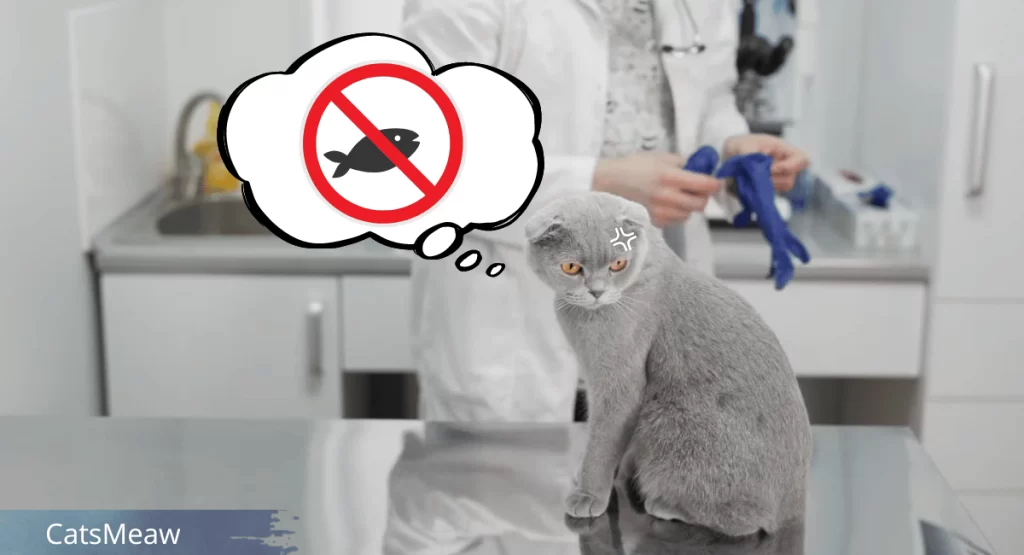When you think of cats, one of the first images that might pop into your mind is of a feline happily nibbling on a small fish. It’s a stereotype that’s been around for ages – cats and fish go together like peanut butter and jelly. However, what if I told you that not all cats can enjoy this seemingly perfect match? Yes, it might come as a surprise, if we talk about Fish Allergy in Cats.

As a cat owner, it’s crucial to recognize the signs of such allergies and understand how to manage them effectively. In this article, we’ll dive deep into the world of cats with fish allergies, exploring everything from symptoms to alternative diets.
Table of Contents
Common Signs and Symptoms of Cat Allergies
When it comes to cat allergies, the signs can often be subtle and easily overlooked. However, as a responsible cat owner, it’s essential to keep an eye out for any unusual behavior or physical changes in your feline friend. Some common signs of allergies in cats include excessive grooming, leading to hair loss and skin sores, frequent scratching, sneezing, coughing, and even vomiting or diarrhea. In some cases, cats may develop more severe symptoms, such as swelling around the face or difficulty breathing, which requires immediate veterinary attention.
It’s worth noting that these symptoms are not exclusive to food allergies and can indicate other health issues. Therefore, it’s crucial not to jump to conclusions and instead seek professional advice from a veterinarian.
Types of Cat Allergies
Cats can develop allergies to a wide range of substances, categorized into three main types: food allergies, contact allergies, and inhalant allergies. Food allergies occur when a cat’s immune system mistakenly identifies a specific ingredient in their diet as harmful, leading to an allergic reaction. Contact allergies, on the other hand, are triggered by physical contact with an allergen, such as certain types of bedding or flea collars. Lastly, inhalant allergies are caused by airborne allergens, including pollen, mold, and dust mites.
Understanding the different types of cats allergies can help cat owners identify potential triggers and take appropriate action to alleviate their pet’s discomfort.
Understanding Fish Allergies in Cats
Fish allergy in cats are a type of food allergy. The proteins found in fish are the usual suspects that trigger an allergic reaction. Unlike some food allergies that manifest immediately, fish allergies can develop over time, even if a cat has been eating fish without any issues for years. This delayed onset can make diagnosing fish allergies in cats particularly challenging.
Related: Healthy Homemade Cat Food Recipes
One key aspect to remember is that a fish allergy in cats does not necessarily mean your cat is allergic to all types of fish. Some cats may react to specific fish varieties, while others might be sensitive to all seafood. This variability further complicates the identification of the allergen.
Diagnosing a Fish Allergy in Cats
Diagnosing a fish allergy in cats involves a process of elimination, known as an elimination diet trial. Under the guidance of a veterinarian, the cat is switched to a diet that contains none of the ingredients suspected of causing the allergic reaction, including fish. If the symptoms subside during this period, it suggests that one of the eliminated ingredients was the culprit.
After the initial phase, individual ingredients are gradually reintroduced into the cat’s diet to pinpoint the specific allergen. This methodical approach is currently the most effective way to diagnose food allergies in cats, including those related to fish.
Managing a Fish Allergy in Cats
Managing a fish allergy in cats primarily involves dietary modifications. Once the specific allergen is identified, it must be permanently excluded from the cat’s diet. This might mean switching to a commercially available cat food that is free from fish and fish derivatives or preparing homemade meals under the guidance of a veterinarian or a pet nutritionist.
Our pick: The Best Cat Food for Indoor Cats
It’s also important to be vigilant about treats and supplements, as these can sometimes contain fish or fish oils, which could trigger an allergic reaction. Reading labels and being mindful of the ingredients in your cat’s diet is key to successfully managing a fish allergy in cats.
Alternative Protein Sources for Cats with Fish Allergies
Finding alternative protein sources is crucial for cats with fish allergies. Fortunately, there are plenty of options available, including chicken, turkey, beef, and lamb. Some commercially available hypoallergenic cat foods use novel protein sources, such as venison or duck, which are less likely to trigger an allergic reaction. Additionally, hydrolyzed protein diets, where the protein molecules are broken down into smaller segments, can be beneficial as the immune system no longer recognizes them as allergens.

When introducing a new protein source, it’s advisable to do so gradually to allow your cat’s digestive system to adjust and to monitor for any adverse reactions.
Homemade Cat Food Recipes for Fish-Allergic Cats
Preparing homemade meals for your cat can be a rewarding way to manage the fish allergy in cats, provided you follow recipes formulated by animal nutrition experts. One simple recipe involves combining a novel protein source, such as cooked, finely chopped turkey, with a carbohydrate like cooked pumpkin or peas, and a prescribed amount of a balanced vitamin and mineral supplement designed for cats.
Related: Wet Food For Cats With Sensitive Stomachs
It’s crucial to consult with a veterinarian or a pet nutritionist before embarking on a homemade diet to ensure it meets all of your cat’s nutritional needs. Homemade diets require careful planning and commitment to avoid nutritional deficiencies.
Tips for Preventing Fish Allergies in Cats
While it’s impossible to guarantee that your feline will never develop a fish allergy in cats, there are steps you can take to minimize the risk. One approach is to offer a varied diet from an early age, which can help prevent sensitivities to specific ingredients from developing. Additionally, opting for high-quality cat foods that use whole food ingredients rather than by-products and artificial additives can support your cat’s overall health and potentially reduce the likelihood of allergies.
It’s also advisable to pay close attention to your cat’s reaction to new foods and to consult with a veterinarian at the first sign of an allergic reaction. Early intervention can make managing allergies much easier in the long run.
Conclusion
Discovering the fish allergy in cats can be a surprising and challenging experience. However, with the right knowledge and approach, it’s entirely possible to manage this condition and ensure your feline friend leads a happy, healthy life. By recognizing the signs of allergies, understanding the types and causes, and making appropriate dietary adjustments, you can provide your cat with the care they need to thrive despite their sensitivity to seafood. Remember, consulting with a veterinarian is always the first step in addressing any health concerns with your pet, including allergies.

